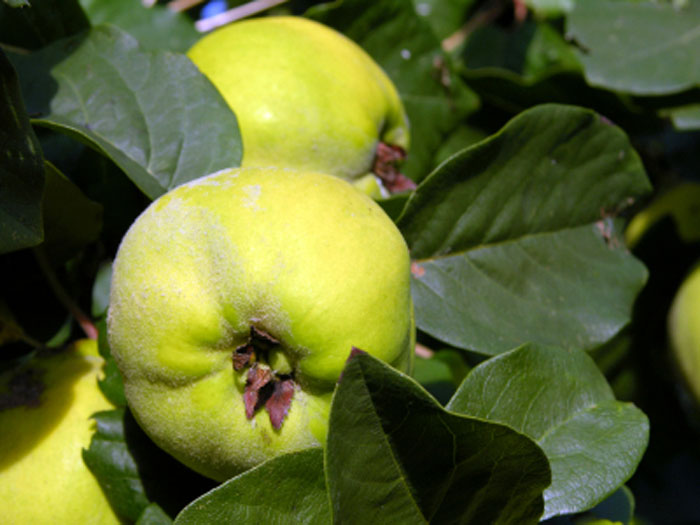Quince: The Oldest Fruit You’ve Never Heard Of

When it comes to fruits, quince isn’t the first one that comes to mind. In fact, there’s a good chance you’ve never even heard of it. Yet the quince has been around since ancient times, and it’s closely related to the apple and the pear. In fact, it is believed that early references to the apple may have been mistranslated, and instead referred to the quince.
Native to southwest Asia, the quince is a pome fruit that grows best in moderate climates with warm summers. Today quinces are grown in Europe, Latin America, Australia and New Zealand. They are rare in the United States due to their vulnerability to fireblight disease, but they are often imported from Argentina.
What is It?
The quince looks strikingly similar to a pear. It has tough, golden skin, dry flesh and a seeded center. Its scent is often considered its best quality. Most quinces have a sour and unpleasant taste when consumed raw, but those that are softened by frost or allowed to ripen thoroughly on the tree taste somewhat better. They are harvested in late fall.
Quinces are usually cooked before eating. This gives them a much sweeter taste and turns them a deep pink color.
Health Benefits
The raw quince is a good source of vitamin A, vitamin C and iron. Some vitamin C may be lost when the fruit is cooked, but this can be minimized by using a minimal amount of water and avoiding overcooking. Quinces are also a good source of fiber.
The quince has long been used in alternative medicine. Middle Easterners soak its dried pits in water and use the liquid as cough medicine. They also use the seeds to combat pneumonia and other lung ailments. In Malta, quince jam dissolved in boiling water is used for stomach problems.
Fun Fact
In Ancient Greece, the quince was regarded as the fruit of love, marriage and fertility. It was given to newlywed couples as a gift to share on their honeymoon. In Greek mythology, the quince is associated with Aphrodite, the goddess of love.
How to Eat
These days, quinces are most often used to make jams and jellies, either alone or with other fruits. They may also be added to pies and other dishes containing apple to add color and enhance flavor. Baked, poached or stewed quince makes a refreshingly different side dish. Quince may be cooked with meats such as pork, lamb or turkey to add flavor.
Quinces should be used quickly once they are ripe. They may be stored in the refrigerator for up to 2 weeks, but they should be stored separately from other fruits so that they do not pick up its scent.
Quince Recipes
Baked Quince with Cinnamon
3 quince, unpeeled, washed, halved and cored
18 whole cloves
1½ cups water
½ cup port wine
3 cinnamon sticks
? cup white sugar
? cup heavy cream, whipped (optional)
Preheat an oven to 375 degrees F.
Press three cloves into each quince half. Place the fruit in a roasting pan cut-side down. Add the water, wine, and cinnamon sticks to the pan; sprinkle the sugar over the quince.
Bake the fruit in the preheated oven until lightly browned, about 35 to 40 minutes. Turn the quince right-side up and bake until tender, about 10 more minutes.
Remove the pan from the oven and let the quince cool slightly. Transfer each quince half to a plate and drizzle with a tablespoon of juices from the roasting pan and a dollop of whipped cream.
Spicy Quince and Cranberry Chutney
2 cups white sugare
½ teaspoon ground cloves
½ teaspoon ground allspice
1 teaspoon ground cinnamon
½ teaspoon salt
2 cups water
1 pound quinces - peeled, cored, and diced
1 orange, zested (optional)
½ cup orange juice
2 tablespoons white wine vinegar
3 cups fresh or frozen cranberries
Stir the sugar, cloves, allspice, cinnamon, and salt together in a large saucepan. Stir in the water, then bring to a boil over high heat, stirring until the sugar dissolves. Add the quince, and reduce heat to low. Cook and stir until the quince have turned rose colored, 4 to 5 minutes.
Stir in the orange zest, orange juice, vinegar, and cranberries. Bring to a boil over high heat, then reduce heat to medium-low, and cook until the cranberries have burst and the chutney has thickened, about 20 minutes. Cool completely before serving.
Quince Jelly
7½ cups sugar
3 fluid ounces liquid pectin
4½ cups water
3 pounds quinces, cored and chopped, peels on
¼ cup lemon juice
Sterilize 8 (½ pint) jars in boiling water for at least 5 minutes, and have new lids ready.
Place the quinces in a large pot, and pour in water. Bring to a boil, then reduce heat to low, and simmer, covered, for 15 minutes. Strain off 4 cups of the juice. Mix juice with sugar and lemon juice in a heavy pot, and bring to a boil over high heat, stirring constantly. Stir in pectin, and return to a boil. Boil for 1 full minute, stirring constantly. Remove from heat and skim off foam. Ladle into hot sterile jars, and process for 10 minutes in a hot water bath to seal. Refrigerate jelly after opening.
Store sealed jars in a cool dark place. Refrigerate jelly after opening.
| Pattern Categories Browse the categories to help you find the patterns you're looking for. |
||







